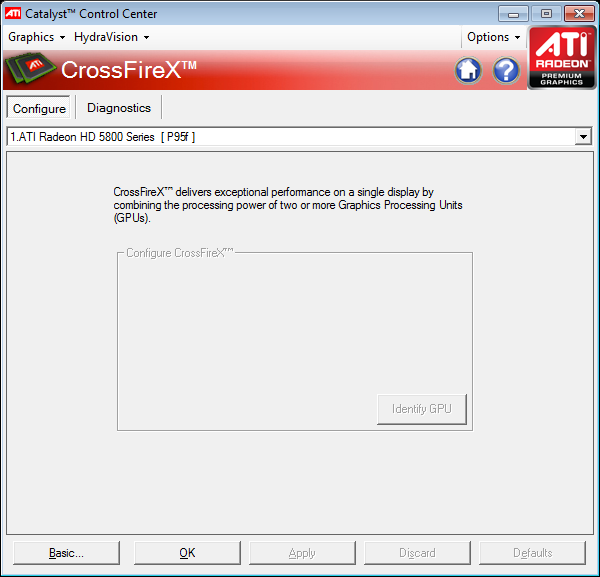Multi-GPU Setups: The Basics Of CrossFire And SLI
Motherboards with multiple PCIe slots are becoming the norm these days, and the trend is being fueled by multi-GPU configurations. Configuring Nvidia's SLI and AMD's CrossFire technologies is easy, but how much more performance can you expect from them?
Driver Installation On AMD Cards
AMD's driver installation either goes just as smoothly as Nvidia's or get ornery. The best-case scenario is that you plug the graphics cards into the mainboard, connect them with a CrossFire bridge, start the system, and install the driver. The worst-case scenario is that cards aren’t recognized by the drivers. If you drop back to only having one card inserted, the driver will install, but as soon as the second card is plugged in, the Catalyst Control Center (AMD's graphics driver interface) returns error messages complaining about missing files, preventing access to the CrossFire settings.
If you run into these issues, you can typically solve them by first installing the main graphics card, and then inserting the second card. If you still can't proceed, remove the CrossFire bridge until the second card is detected correctly in the device manager and all drivers are installed. If this still does not work, you can try installing the first card in your primary PCIe slot, remove it, install the second card in the secondary PCIe slot, and then finally insert the first card in slot one again.
AMD's drivers can be fussy. Even if the driver successfully detects the graphics card, it'll sometimes misbehave if you then try to insert the card into a different PCIe slot. If you install the cards separately, try inserting both and then connect the CrossFire bridge. If you're still having problems, another driver is needed, because uninstalling and reinstalling doesn't always work, either. In our testing, the easiest way to do this turned out to be using the (officially unsupported) drivers from the preview package. Hopefully, this will finally let you use the Catalyst Control Center, because this graphical interface is required to activate CrossFire.
Once CrossFire-compatible cards are installed and the drivers work, CrossFire activation will be suggested. The activation check box is almost always checked by default, but you should still adjust anti-aliasing and texture filtering to taste, and then reboot so that all settings are stored and active. With current AMD drivers, you can't activate CrossFire without a CrossFire bridge physically connecting the graphics cards (unless you're using certain mainstream configurations, which do support operation without bridges). On the bright side, you can use CrossFire with different classes of GPUs. However, performance scaling will be imperfect. Don't expect to get more than twice the performance of the weakest card.
Get Tom's Hardware's best news and in-depth reviews, straight to your inbox.
Current page: Driver Installation On AMD Cards
Prev Page Driver Installation On Nvidia Cards Next Page Connectors-
ramcrazy360 It's great to know there's so little difference between 8x and 16x preformance even with a 5850! I was worried about having a bandwidth issue with two 5770s, but it seems that won't be a problem.Reply -
Maziar Great review,however i wish you tested on resolutions like 2560x1600 and higher,because i think the main difference between 8x and 16x is in resolutions like that.Reply -
wildeast same as ramcrazy,Reply
i was going to get an i5 but that means a p55 mobo (x8+x8) not x58 (x16+x16), so i thought i should be getting x58 and i7 rig which is beyond my savings, thnx tom's am getting i5 + p55 now :) -
Tamz_msc Very nice article.It cleared a lot of confusion in my case.I would have liked to see scaling with increase in the number of CPU cores.Reply -
ruffopurititiwang Great article! Now we know what the deal is regarding multi-gpu and PCI-E lane speeds with mainstream setups.Reply
Now how about showing some love for top of the line setups? Can you apply the same tests to GTX 480/ATI 5870 Multi-gpu configuration + X58 mobo & 980X proc? -
rohitbaran On page 7, performance of Radeons in Alien vs Predator is not arranged properly with CPU speed.Reply -
lothdk rohitbaranOn page 7, performance of Radeons in Alien vs Predator is not arranged properly with CPU speed.Reply
All the tests are arranged by GPU performance not by CPU speed. -
TheStealthyOne I'll definitely be using this article as a reference for a dual 5850 machine I'm building :)Reply -
hixbot In every single TOMS article showing benches on CPU scaling, you use High resolutions with FULL AA and aniso! WHY?!Reply
I know thats how many would play the game, and it shows the performance that one would expect with different CPUs. It shows that we don't need to overclock or buy expensive CPUs, when the load (bottleneck) is on the GPU.
BUT if you would also show the CPU scaling in low resolutions and no AA/aniso, we could see how the CPUs might stack up. This is valuable for knowing how the CPUs perform in the future, when one might have upgraded the GPUs, and the bottleneck dissapears.
Yeah, yeah, this is not a CPU article... i know but still.. it shows CPU scaling, and every time I see CPU scaling demonstrated on toms, it's shown with a bottleneck on the GPU.
Humour us next time and include a bench or two with no GPU bottlneck (low res, eye candy). Just becaause that's not how we'd play the game, and just because the FPS would be insanely high, doesn't mean the numbers wouldn't be valuable. I complain about this in every article that includes CPU scaling.
It doesn't erk me that much here because this article isn't focused on CPUs. but for the love god, the next CPU article you do, when you test gaming, throw a bench or two in there with very low settings.

